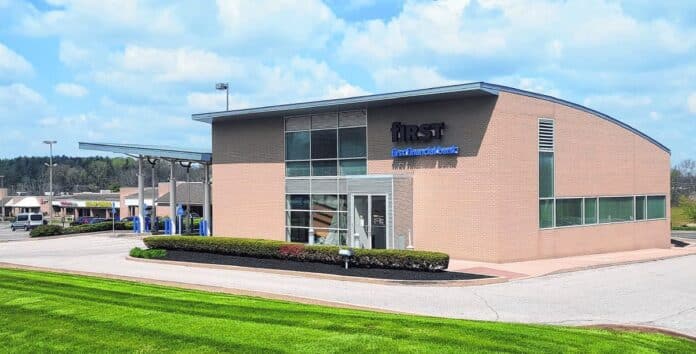
An iconic Columbus building designed as an Irwin Union Bank branch office six decades ago has closed its doors, its future uncertain.
The Eastbrook Plaza banking center at 25th Street and National Road was shuttered April 10 by First Financial Bank, which purchased the assets of the city’s only locally owned bank in 2009.
The one-of-its kind building by the late architect Harry Weese was replaced with a newly built First Financial branch office a mile away. The Eastbrook office site next to Kroger could not compete in geographic location, access and nearby retail.
Weese, the most prolific commercial and public building designer in Columbus during the 1950s and 1960s, drew up a provocative vision for the banking center along Haw Creek.
[sc:text-divider text-divider-title=”Story continues below gallery” ]
It opened in 1961, a year after the shopping center got underway, and became significant for several reasons.
It was the first bank branch outside of downtown Columbus opened by Irwin Union, which began in 1871.
When the branch opened, Irwin Union was led by the late J. Irwin Miller, the Cummins executive who helped Columbus become one of the nation’s leading cities for architecture.
The imaginative Weese pulled out all the stops with the Eastbrook design. The split-level building appears massive from the side, but is quite narrow, architecture historian Rickey Berkey observed. The main floor was raised above the “sea of cars” in the adjacent parking lot — a podium for better outlooks, visibility to the exterior and a sense of separation from the lined parking spaces, Berkey wrote.
Weese described its massive towers, original exterior lighting and adjacent reflecting pool in Haw Creek as reminiscent of a child’s vision of a castle. Others said it resembled a steamship, moored along the creek.
Architecture that takes risks also can generate teasing, and that occurred with the Eastbrook building. Some called it the “dead horse,” its four feet pointing skyward. Those feet were actually the original towers, where three drive-up windows and a night depository were placed before the advent of ATM machines. A 1996 update added an accessibility ramp and new drive-up lanes.
Weese’s glazed brick bank was described as billboard architecture, a term used by design peer Robert Venturi, referring to buildings with unique visual impact to heavy traffic flow.
“That building is a statement,” said Richard McCoy, executive director of the Landmark Columbus Foundation.
It is also important because of the client, architectural patron Miller.
“This is part of our heritage. It is who we are,” McCoy said.
Weese’s design footprints dot the city, from Schmitt Elementary School in 1957 through the Cummins Technical Center in 1968. His work includes Northside Middle School, First Baptist Church and two other former Irwin Union locations — the Hope branch in 1958 and the first State Street corridor branch at 151 S. Mapleton St. in 1961.
Those banks transitioned to new uses. After having been a weekly newspaper office and tourist center, the former Hope branch has operated three years as Hope Wellness Pharmacy. The Mapleton Street office has been Flowers from the Woods flower shop since the mid-1970s.
“Sometimes you have to adapt them for a new use,” McCoy said, as two other Irwin Union building have also done.
The bank’s Modern style headquarters at 500 Washington St., designed for its 1954 opening by Eero Saarinen, became the Irwin Conference Center in 2010. The building, operated by Cummins, was brilliantly adapted, McCoy said. Two blocks south, the 1881 Victorian style bank building at 301 Washington St., which housed
Miller’s second-floor personal office, was remodeled in 2011 — also by Cummins. But not all architecturally significant buildings survive, as retrofitting old banks can be challenging.
The Irwin Union bank at Taylorsville, designed in 1966 by Fisher and Spillman, was part of Columbus’ architectural heritage. But it sat abandoned after the office closed, razed in 2014. The land was purchased by Carver Toyota next door.
The 1974 east side Irwin Union branch office at 2033 State St., designed by Paul Kennon, was last used as a bank more than a decade ago. It became a West Trucking office in 2012, and was sold three years later to Columbus Regional Health as a potential site for Volunteers in Medicine.
When those plans fizzled, the State Street building sat vacant another five years. Kennon’s two-story building featured a lobby with glass on three sides — dramatic, modern and functional.
“His tall, open glass lobby was meant to reflect the openness in banking that had been a tradition of Irwin Union Bank,” Berkey wrote.
Columbus Regional contacted preservationists and county organizations in an effort to save the building, but architectural angels have yet to come forward.
“It has so many things that challenge its use,” McCoy said. “It’s just as much of a preservation problem as an economic problem.”
First Financial is seeking a buyer for its Eastbrook building, but a new tenant may have to come from outside banking considering trends.
Two Washington Street bank buildings with long histories have closed — PNC (1869) a year ago and Old National Bank (1960) two weeks ago. Nearby, a German American branch (1900) is slated to close May 29.
“It’s not that these buildings don’t matter,” McCoy said.
However, there isn’t demand for buildings in Columbus right now and technology is changing the banking landscape. When new banking offices are built, they tend to follow a corporate design.
“The Irwin Union banks, they were all so wildly unique,” McCoy said. “You can only see that in Columbus, Indiana.”
Two Irwin Union banking centers still operate under the First Financial flag. The West Hill Shopping Center branch by architect Carlos Jimenez opened in 2004, using a layout that could rotate to accommodate different site conditions.
Across town, the final Irwin Union branch was built in 2007 near Kohl’s Department Store, replacing the State Street office.
The Deborah Berke building won a design award from the American Institute of Architects, and Dwell magazine said “it may be the most refined bank branch in the world.”
Regarding Irwin Union’s building portfolio in Columbus, “there’s nothing like that in America,” McCoy said.
If the Eastbrook building doesn’t survive, the “Athens of the Prairie” — as Columbus is known — will lose part of its architectural heritage.
[sc:pullout-title pullout-title=”On the Web” ][sc:pullout-text-begin]
See a gallery of all Irwin Union Bank’s Columbus buildings at therepublic.com
[sc:pullout-text-end]
Retired editor Tom Jekel writes a weekly column that appears each Sunday on The Republic’s Opinion page. Contact him by email through [email protected].



